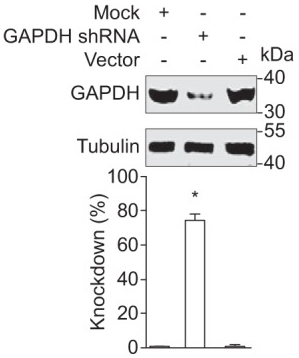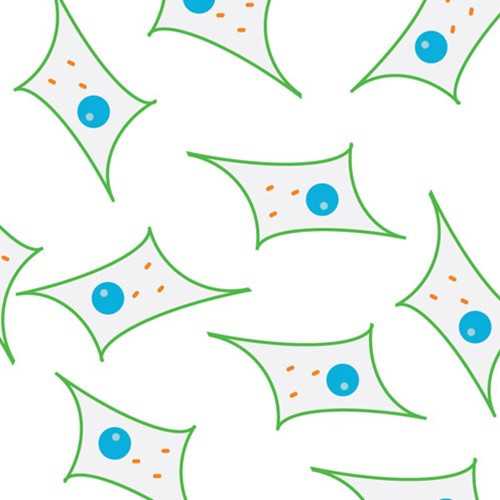GAPDH Knock Down HEK293T Cell Line (GAPDH-KD)
Human embryonic kidney 293T (HEK293T) cells with the GAPDH gene knocked down by shRNA.
Highlights:
- HEK293T cells were transfected with the shRNA plasmid psi-LVRU6GP targeting the GAPDH 3'-UTR mRNA
- Stable cell lines were created using puromycin selection
Glyceraldehyde 3-phosphate dehydrogenase (GAPDH) is an enzyme that catalyzes the sixth step of glycolysis and thus serves to break down glucose for energy and carbon molecules. In addition to this long established metabolic function, GAPDH has recently been implicated in several non-metabolic processes, including transcription activation, initiation of apoptosis, ER to Golgi vesicle shuttling, and fast axonal, or axoplasmic transport. In sperm, a testis-specific isoenzyme GAPDHS is expressed.
From the laboratory of Philip R. Hardwidge, PhD, Kansas State University.
Human embryonic kidney 293T (HEK293T) cells with the GAPDH gene knocked down by shRNA.
Highlights:
- HEK293T cells were transfected with the shRNA plasmid psi-LVRU6GP targeting the GAPDH 3'-UTR mRNA
- Stable cell lines were created using puromycin selection
Glyceraldehyde 3-phosphate dehydrogenase (GAPDH) is an enzyme that catalyzes the sixth step of glycolysis and thus serves to break down glucose for energy and carbon molecules. In addition to this long established metabolic function, GAPDH has recently been implicated in several non-metabolic processes, including transcription activation, initiation of apoptosis, ER to Golgi vesicle shuttling, and fast axonal, or axoplasmic transport. In sperm, a testis-specific isoenzyme GAPDHS is expressed.
From the laboratory of Philip R. Hardwidge, PhD, Kansas State University.
| Product Type: | Cell Line |
| Name: | GAPDH-KD |
| Cell Type: | HEK293T |
| Accession ID: | P04406 |
| Organism: | Human |
| Biosafety Level: | BSL2 |
| Growth Conditions: | DMEM, high glucose + 10% FBS |
| Subculturing: | Change media every 2-3 days |
| Cryopreservation: | 40 % DMEM, 10 % DMSO, 50 % FBS |
| Storage: | Liquid nitrogen |
| Shipped: | Dry Ice |

GAPDH knock down efficiency. HEK293T cells were transfected with the shRNA plasmid psi-LVRU6GP targeting the GAPDH 3′-UTR mRNA. Stable cell lines were created using puromycin selection. Tubulin was used to normalize GAPDH abundance. Asterisks indicate protein abundance significantly different from that of the control (n = 3, ANOVA).
Adapted from: El Qaidi S, et al. J Biol Chem. 2017 Jul 7;292(27):11423-11430.
- El Qaidi S, Chen K, Halim A, Siukstaite L, Rueter C, Hurtado-Guerrero R, Clausen H, Hardwidge PR. NleB/SseK effectors from Citrobacter rodentium, Escherichia coli, and Salmonella enterica display distinct differences in host substrate specificity. J Biol Chem. 2017 Jul 7;292(27):11423-11430. doi: 10.1074/jbc.M117.790675. Epub 2017 May 18. PubMed PMID: 28522607; PubMed Central PMCID: PMC5500807.
If you publish research with this product, please let us know so we can cite your paper.


